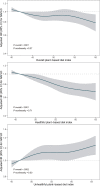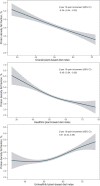Plant-based diets, genetic predisposition and risk of non-alcoholic fatty liver disease
- PMID: 37697334
- PMCID: PMC10496397
- DOI: 10.1186/s12916-023-03028-w
Plant-based diets, genetic predisposition and risk of non-alcoholic fatty liver disease
Abstract
Background: Diets rich in plant-based foods are associated with lower risks of non-alcoholic fatty liver disease (NAFLD), while the prospective evidence is limited. We aimed to examine longitudinal associations of plant-based diets and genetic susceptibility with NAFLD risk.
Methods: This longitudinal cohort study included 159,222 participants (58.0 ± 8.0 years old, 55.7% female) free of NAFLD in the UK Biobank. We calculated the overall plant-based diet index (PDI), the healthful plant-based diet index (hPDI), and the unhealthful plant-based diet index (uPDI). New-onset NAFLD was the primary outcome. The weighted polygenic risk score was calculated based on risk variants associated with NAFLD. Hazard ratios (HR) and 95% confidential intervals (CI) were estimated by Cox proportional hazards model. Magnetic resonance imaging-derived proton density fat fraction (MRI-PDFF) measured liver fat content in a subsample of 20,692 participants (57.5 ± 7.4 years old, 52.6% female) was the secondary outcome. The associations between plant-based diet indices and MRI-PDFF were evaluated using generalized linear models.
Results: During a median follow-up of 9.5 years, 1541 new-onset NAFLD cases were documented. Compared to the lowest quintile, multivariable-adjusted hazard ratios (HRs) of NAFLD in the highest quintile were 0.78 (95% confidential intervals [CI], 0.66-0.93, p-trend =0.02), 0.74 (95% CI, 0.62-0.87, p-trend <0.0001), and 1.24 (95% CI, 1.05-1.46, p-trend = 0.02) for overall PDI, hPDI, and uPDI, respectively. For liver fat content, higher overall PDI and hPDI were associated with lower MRI-PDFF, while higher uPDI was associated with higher liver fat content. We observed a significant interaction between hPDI and PRS (p-interaction =0.03), and the NAFLD risk was lowest among participants with the highest hPDI and low genetic risk.
Conclusions: Higher intake of plant-based diets especially healthful plant-based diets was associated with lower NAFLD risk and liver fat content regardless of genetic susceptibility, whereas an unhealthful plant-based diet was associated with higher NAFLD risk and intrahepatic steatosis. These results suggest that the quality of plant-based foods should be highlighted when adopting a plant-based diet.
Keywords: Genetic risk; NAFLD; Plant-based diet; UK Biobank.
© 2023. BioMed Central Ltd., part of Springer Nature.
Conflict of interest statement
The authors declare that they have no competing interests.
Figures


Similar articles
-
Plant-based diets, genetic predisposition, and the risk of adult-onset asthma A prospective study.Eur J Nutr. 2025 Jul 28;64(6):249. doi: 10.1007/s00394-025-03757-z. Eur J Nutr. 2025. PMID: 40719857
-
Plant-based dietary patterns, genetic predisposition and risk of colorectal cancer: a prospective study from the UK Biobank.J Transl Med. 2023 Sep 27;21(1):669. doi: 10.1186/s12967-023-04522-8. J Transl Med. 2023. PMID: 37759216 Free PMC article.
-
Plant-based diet quality and the risk of total and disease-specific mortality: A population-based prospective study.Clin Nutr. 2021 Dec;40(12):5718-5725. doi: 10.1016/j.clnu.2021.10.013. Epub 2021 Oct 25. Clin Nutr. 2021. PMID: 34749131
-
Scoping review of the association of plant-based diet quality with health outcomes.Front Nutr. 2023 Aug 10;10:1211535. doi: 10.3389/fnut.2023.1211535. eCollection 2023. Front Nutr. 2023. PMID: 37637943 Free PMC article.
-
Associations between plant-based diets and cardiovascular disease, frailty, and cognitive dysfunction in middle and old age: a systematic review and meta-analysis of cohort studies.Food Funct. 2025 May 19;16(10):4061-4084. doi: 10.1039/d4fo03384a. Food Funct. 2025. PMID: 40298944
Cited by
-
Accelerometer-derived moderate-to-vigorous physical activity and incident nonalcoholic fatty liver disease.BMC Med. 2024 Sep 18;22(1):398. doi: 10.1186/s12916-024-03618-2. BMC Med. 2024. PMID: 39289727 Free PMC article.
-
Milpa Diet for MASLD in Mesoamerican Populations: Feasibility, Advantages, and Future Perspectives.Life (Basel). 2025 May 19;15(5):812. doi: 10.3390/life15050812. Life (Basel). 2025. PMID: 40430238 Free PMC article. Review.
-
Sex Differences in the Association Between the Korean Healthy Eating Index and Liver Enzymes Among Korean Adults.Nutrients. 2025 Jul 20;17(14):2372. doi: 10.3390/nu17142372. Nutrients. 2025. PMID: 40732997 Free PMC article.
-
Fast food consumption and risk of non-alcoholic fatty liver disease: a systematic review and meta-analysis.Front Public Health. 2025 Jul 30;13:1600826. doi: 10.3389/fpubh.2025.1600826. eCollection 2025. Front Public Health. 2025. PMID: 40809752 Free PMC article.
-
Quality of plant-based diets in relation to all-cause and cardiovascular disease mortality in US adults with sarcopenia: a population-based study.Aging Clin Exp Res. 2025 Jun 1;37(1):176. doi: 10.1007/s40520-025-03080-x. Aging Clin Exp Res. 2025. PMID: 40450643 Free PMC article.
References
Publication types
MeSH terms
LinkOut - more resources
Full Text Sources
Medical

